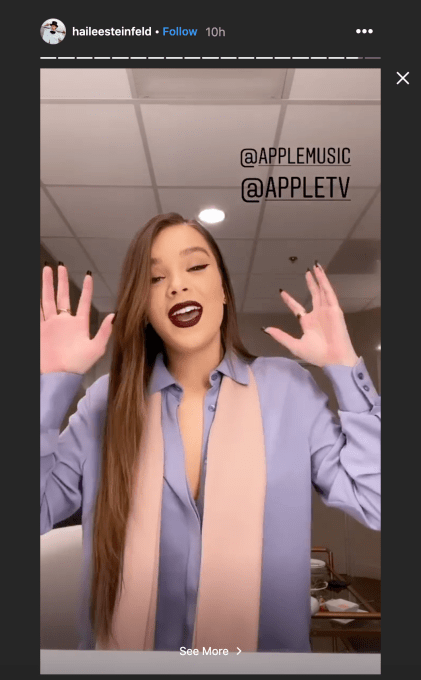Ahead of Friday’s launch of Apple’s new streaming service, Apple TV+, the company announced an Apple Music/Apple TV+ bundle deal specifically aimed at making the service more affordable for younger subscribers. According to an Instagram Story published by Hailee Steinfeld, star of Apple TV+’s first potential hit series, Dickison, Apple Music student subscribers will be able to stream Apple TV+ for free.
The announcement was spotted earlier by 9to5Mac.
After a series of Instagram-hosted Q&A’s meant to stoke excitement for the show among her fans, Steinfeld announced the bundle deal by saying that: “for those of you who are students with an Apple Music student subscription, you can now get Apple TV+ for free.”
 She noted this means student subscribers will not only be able to watch her new show on Friday, November 1st, they can also check out her new single “Afterlife” with the same subscription.
She noted this means student subscribers will not only be able to watch her new show on Friday, November 1st, they can also check out her new single “Afterlife” with the same subscription.
The Apple Music student subscription is currently $4.99 per month, which provides full access to Apple Music’s catalog of 50 million songs, live local radio stations, curated playlists, and other original content.
An Apple Music-Apple TV+ bundle had been rumored to be in the works, prompting rival Spotify to team up with Hulu to pre-emptively strike with a bundle deal of their own.
But when Apple formally announced its TV streaming service, it instead surprised everyone by offering the service for free with the purchase of a new Apple device.
Of course, students are less likely to upgrade their phones and tablets as often as working adults, given the costs. That means they would have missed out on the “new device” deal, and would have instead had to pay the $4.99 per month subscription for the TV service.
Meanwhile, Apple TV+’s debut shows have received mixed reviews from critics ahead of launch — with the star-powered The Morning Show featuring Jennifer Aniston, Reese Whitherspoon, and Steve Carell even being called “dull” and “underwhelming.” Dickison, however, has been a bright spot, with some even saying the show is set to be Apple TV+’s breakout series. It would make sense for Apple to capitalize on that attention — as well as on Steinfeld’s 12.4 million Instagram followers — to get more people watching.
Apple didn’t share any additional information about the Music/TV+ bundle beyond what Steinfeld announced. There was no related press release or even a tweet posted to the Apple TV Twitter account. In other words, Apple was narrowly targeting Steinfeld’s built-in fan base with the news.
It appears this is not a limited-time deal with an expiration date attached, just an ongoing benefit of a student Music subscription.
from TechCrunch https://ift.tt/2NswHET
via IFTTT
Comments
Post a Comment